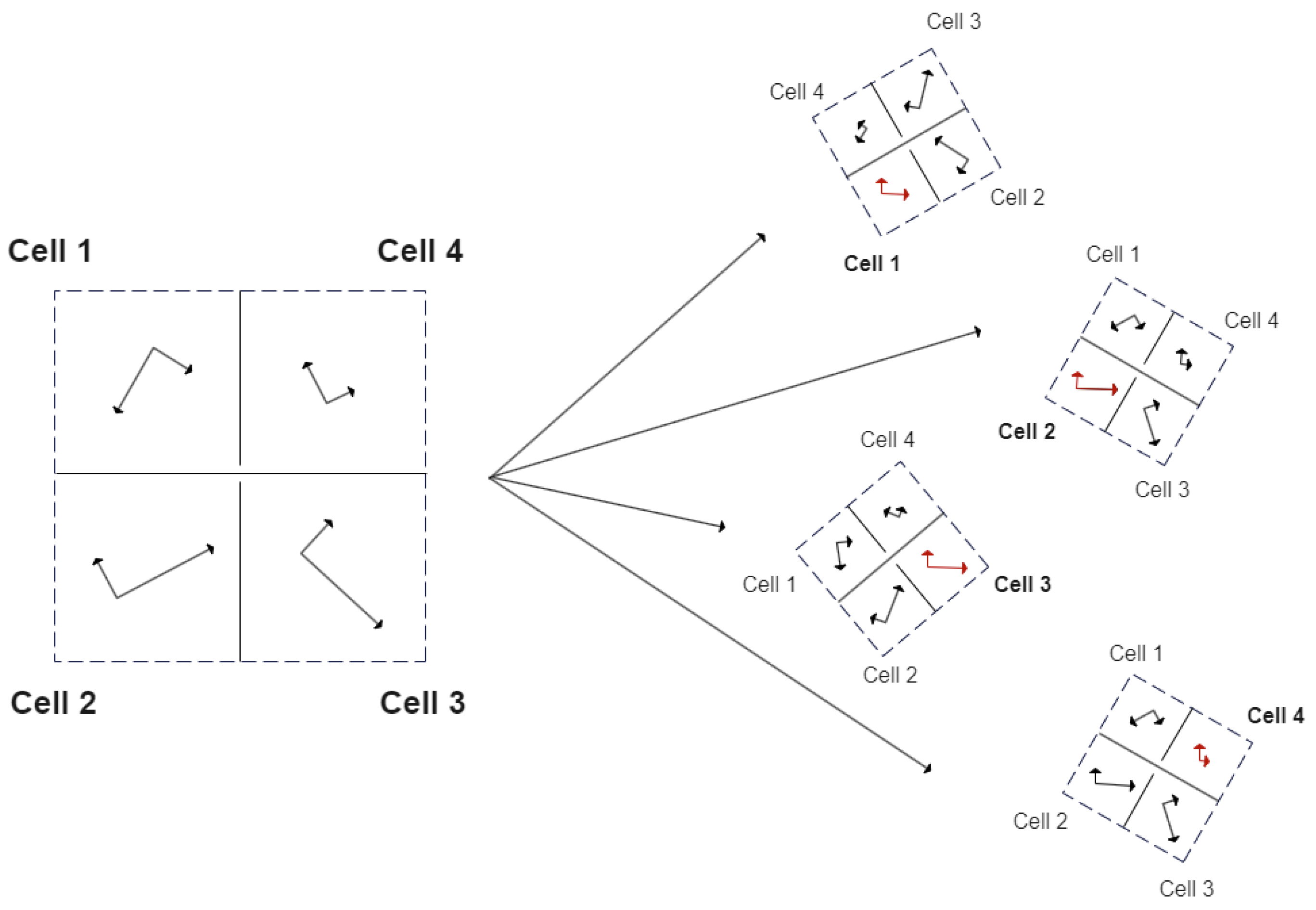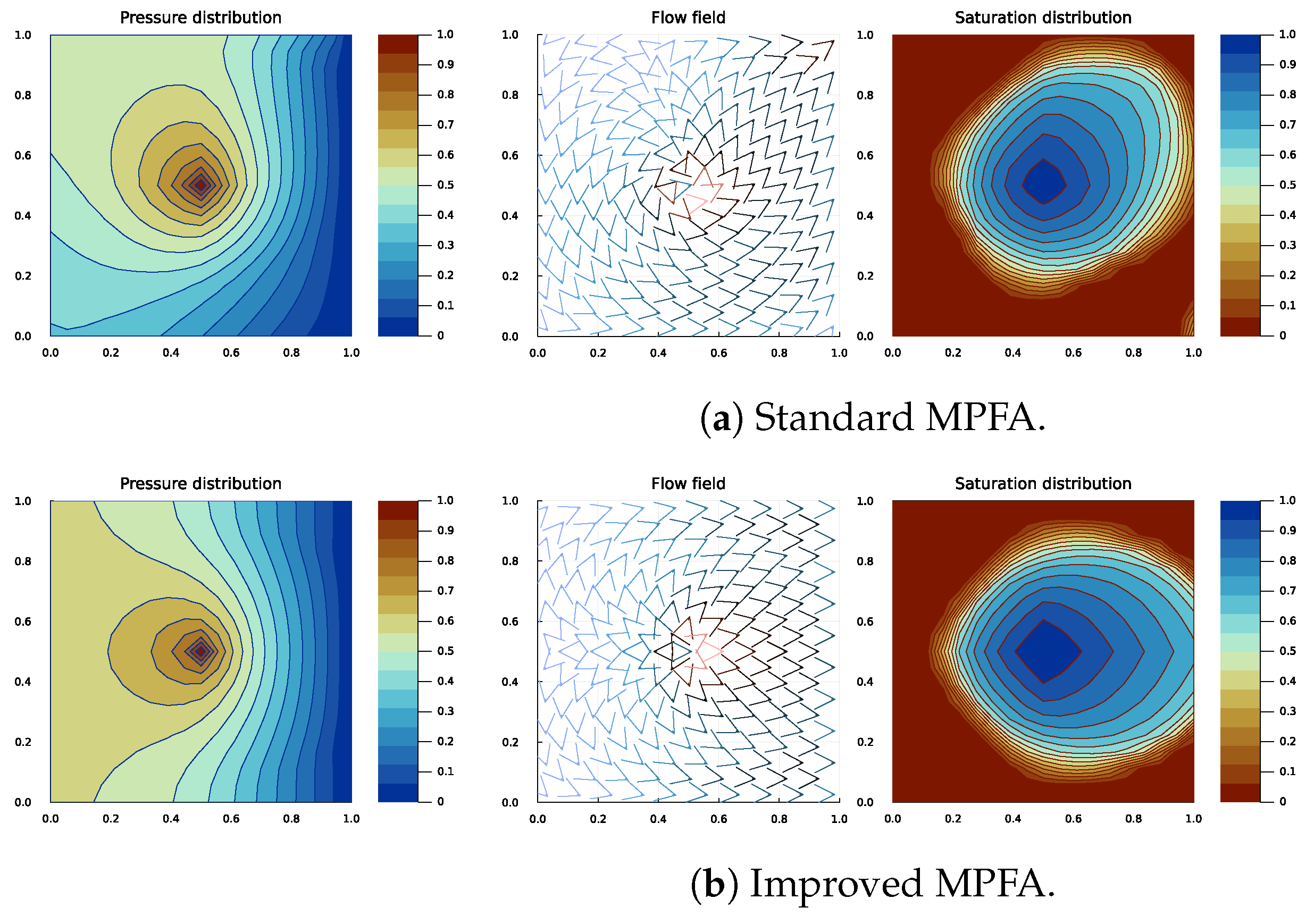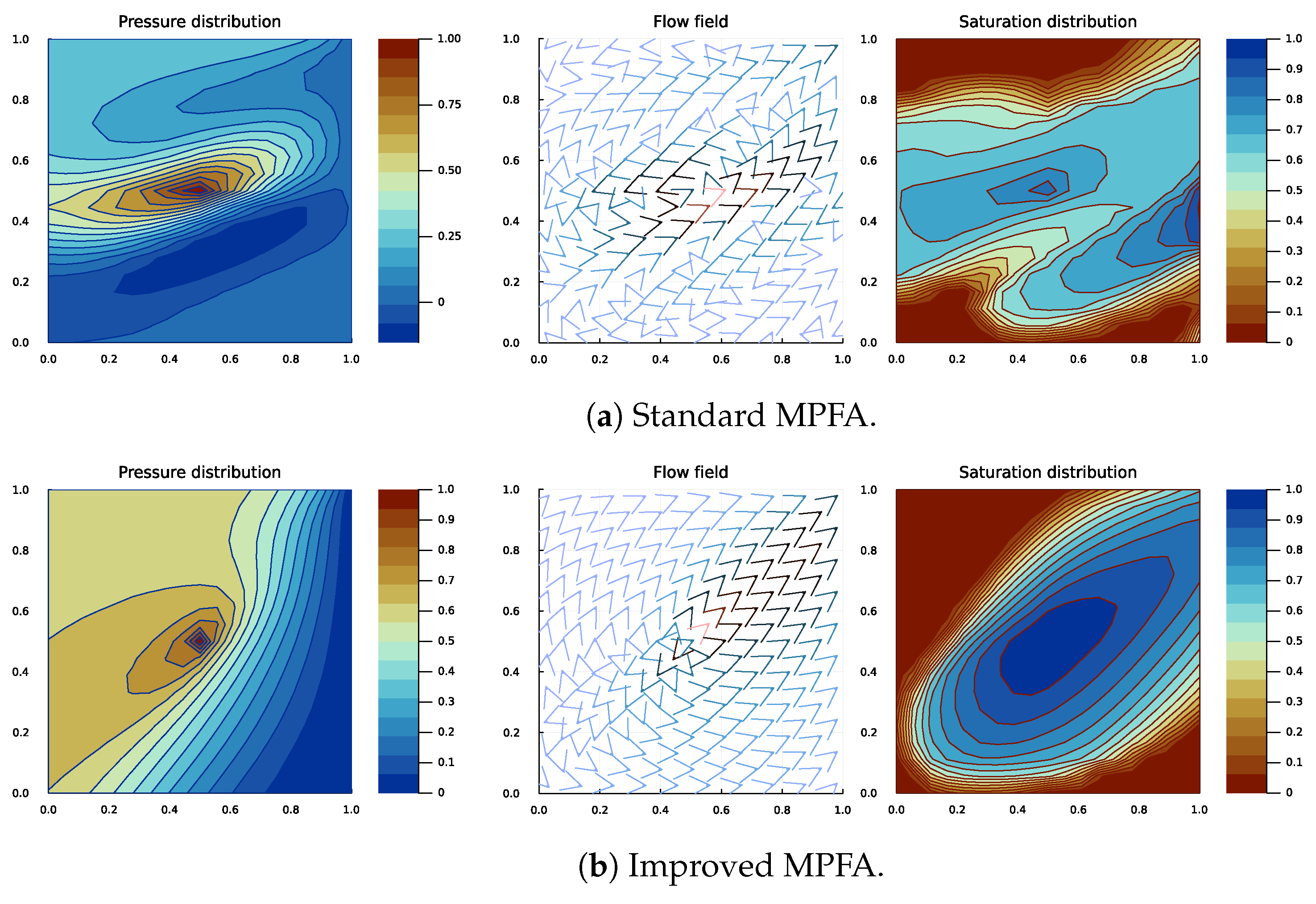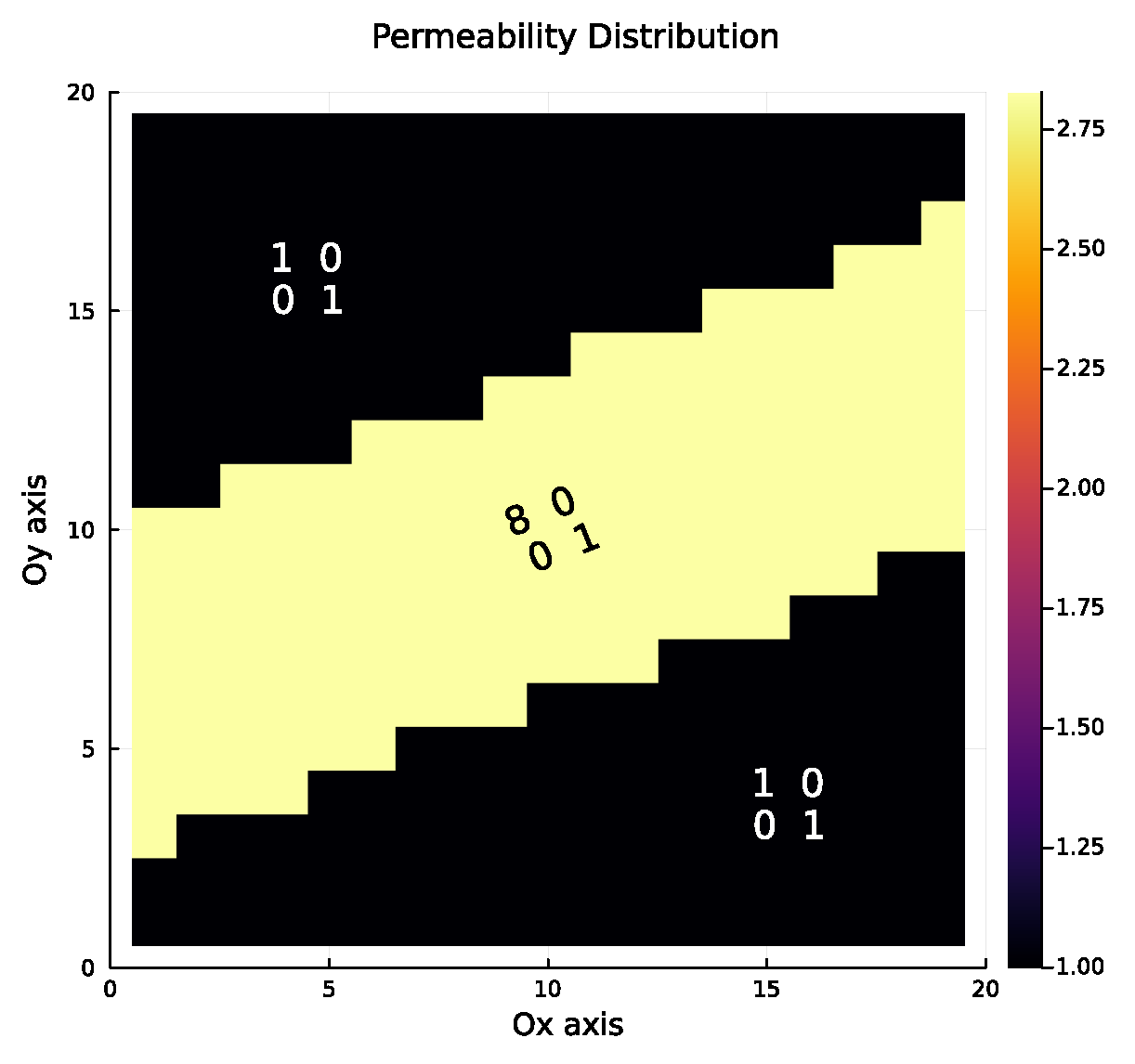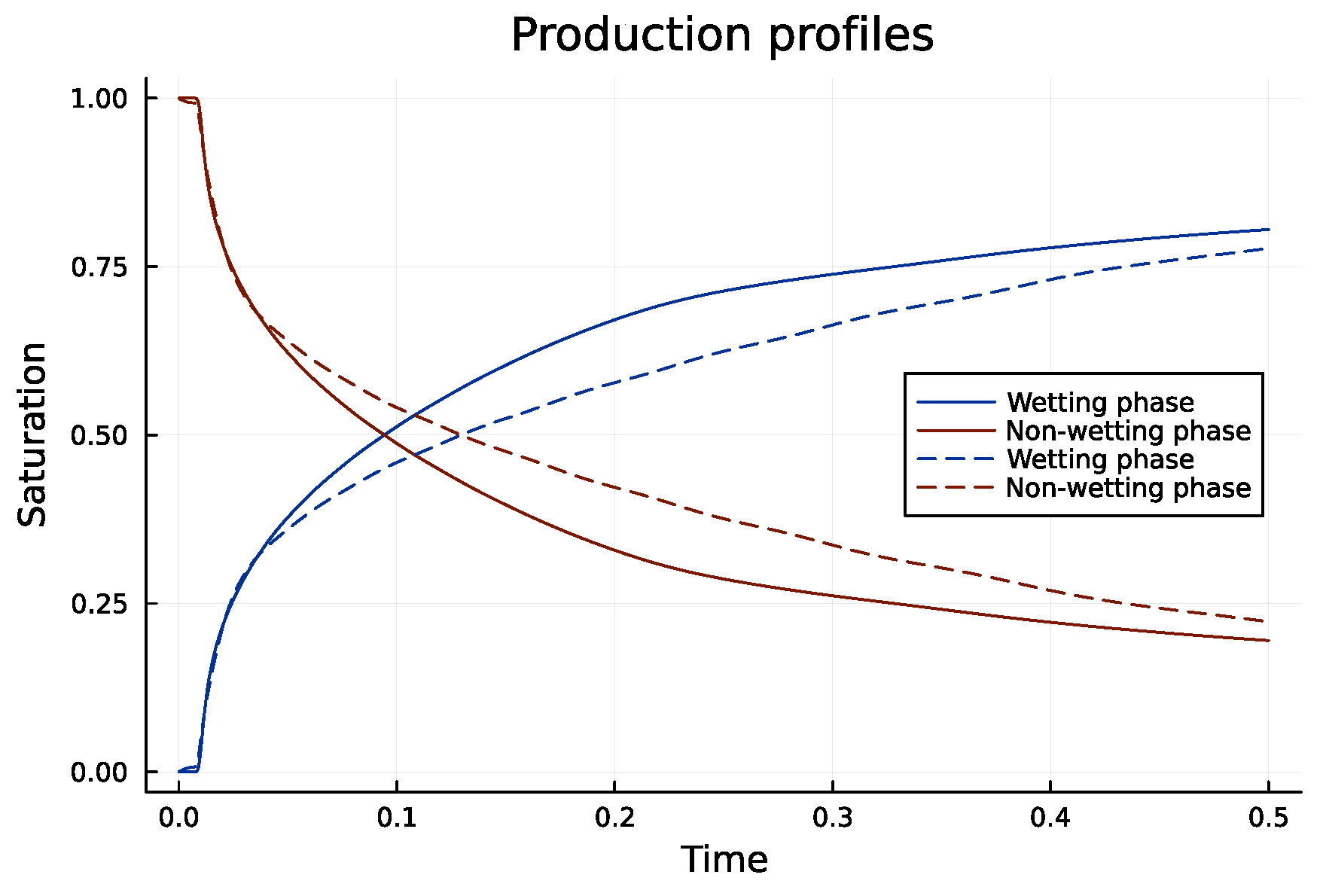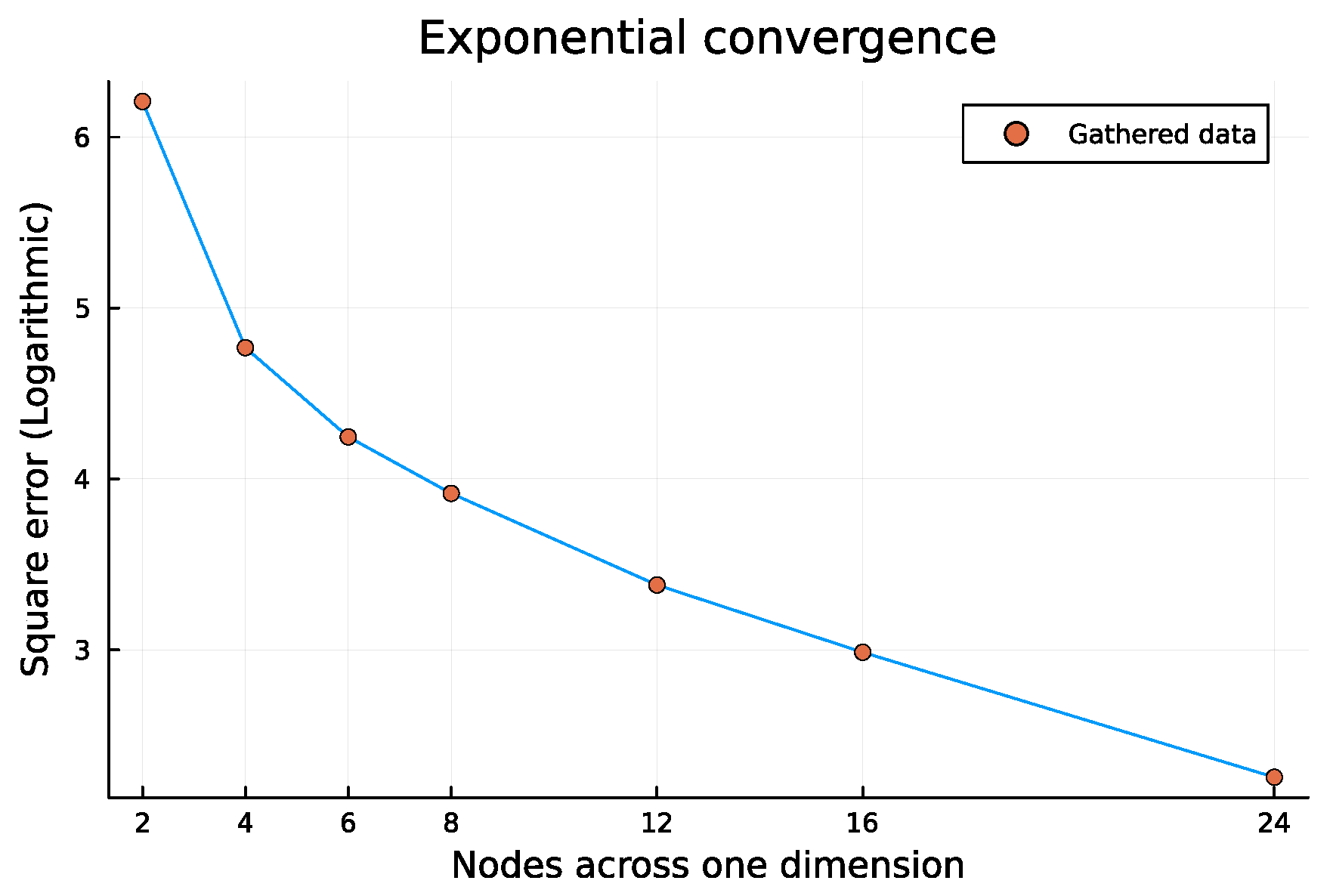1. Introduction
Subsurface reservoirs are vital for numerous energy and environmental applications, including CO
2 sequestration, hydrogen storage, geothermal energy extraction, and hydrocarbon production. These systems are inherently complex, involving heterogeneous geological formations with intricate geometries, sharp contrasts in permeability, and anisotropic properties. Accurately modeling the flow and transport of fluids in such settings requires advanced numerical methods capable of addressing these challenges while maintaining computational efficiency and stability. The standard workflow for developing a computational model involves the formulation of a rigorous mathematical framework that accurately describes the underlying physical phenomena, followed by its translation into a numerical model amenable to a computational solution [
1].
Among the various numerical methods, finite volume methods (FVMs) have emerged as a robust approach to modeling subsurface flow problems. They are favored for their ability to conserve fluxes both locally and globally [
2,
3], making them particularly suited for problems involving discontinuous material properties and anisotropic permeability. Standard methods like the two-point flux approximation (TPFA) are widely used but exhibit significant limitations on non-K-orthogonal grids or in the presence of full-tensor permeability fields [
4]. This has motivated the development of more sophisticated methods, such as the multipoint flux approximation (MPFA) family [
5], which addresses many of the shortcomings of TPFA by incorporating additional support points to capture diagonal and off-diagonal flux components.
The MPFA-O method is one of the most commonly used variants within the MPFA framework due to its generality and accuracy. By incorporating contributions from diagonal neighbors, it effectively handles full-tensor permeability on non-K-orthogonal grids. However, its application is not without challenges. In the presence of strong anisotropy or highly misaligned grids, the MPFA-O method can produce spurious oscillations, violate the maximum principle, and exhibit non-monotonic behavior [
6]. These numerical artifacts undermine the physical realism of the simulation and limit the method’s applicability in practical reservoir modeling scenarios. Several approaches, including reduced stencils like the MPFA-U [
7] and MPFA-D [
8] as well as flux-splitting techniques [
9,
10], have been proposed to address these issues, but they often come with trade-offs in terms of computational complexity, accuracy, or generality.
While significant progress has been made in improving the stability and accuracy of pressure equation solvers, modeling coupled multiphase flows in subsurface reservoirs remains a major challenge [
11,
12]. In such systems, the pressure and saturation equations are tightly coupled, with the pressure field driving fluid movement and the saturation field influencing pressure dynamics through relative permeability and capillary pressure effects. The inclusion of the saturation equation introduces additional nonlinearities and interdependencies that complicate the numerical solution process. Accurately capturing the coupled behavior of these equations is critical for simulating real-world phenomena, such as waterflooding in oil reservoirs, gas injection for enhanced recovery, and the migration of CO
2 plumes in sequestration projects.
Saturation dynamics are governed by transport equations that describe the movement and redistribution of fluid phases in porous media. These equations are highly nonlinear and often exhibit sharp fronts or discontinuities due to the heterogeneous and anisotropic nature of subsurface reservoirs. Numerical methods for solving saturation equations must ensure physical accuracy while preserving properties like monotonicity and positivity, especially in the context of multiphase flows. Standard methods often struggle to balance these requirements, leading to numerical instabilities or excessive computational cost. Increasing the method’s efficiency with multigrid methods [
13], adaptive local mesh refinement [
14], and parallelization [
15] is a viable approach. However, we strived to maintain the simplicity of numerical software and maximize the method’s inherent versatility, accuracy, and computational efficiency. The emerging field of quantum computing has the potential to enhance the solution of differential equations [
16] and is theoretically expected to provide a polynomial speedup for finite element methods [
17].
The MPFA-O method, which has been extensively used for solving pressure equations, offers an attractive foundation for extending numerical modeling capabilities to include saturation dynamics. However, integrating the saturation equation into the MPFA-O framework is nontrivial and requires addressing several key aspects. These include ensuring stability and accuracy in the presence of strong coupling between pressure and saturation fields, handling full-tensor permeability with complex geological layering, and maintaining computational efficiency on large-scale problems with fine resolutions.
The improved MPFA approach introduced in this study extends the stability-enhancing modifications applied to pressure computations in previous work [
18] to the saturation equation, addressing numerical stability and spurious oscillations on non-K-orthogonal grids. Such grids refer to grid configurations where the connection vector between adjacent cell centers is not aligned with the principal directions of the permeability tensor. This misalignment can lead to significant numerical errors in standard MPFA methods, where the discretization of the saturation equation suffers from unstable saturation profiles, particularly in highly anisotropic domains. To mitigate these issues, the improved method integrates local permeability tensor rotations and improved flux approximations, ensuring a more accurate representation of fluid transport dynamics.
The primary contributions of this study are threefold: (1) the formulation of a unified framework that seamlessly integrates the pressure and saturation equations within the MPFA-O method, (2) the implementation of stability-enhancing techniques to mitigate spurious oscillations and ensure monotonicity in the numerical solution, and (3) the demonstration of the method’s performance through numerical experiments on heterogeneous, anisotropic domains using non-K-orthogonal grids. By addressing these objectives, the proposed method offers a significant step forward in the development of reliable and efficient tools for subsurface reservoir simulation.
The motivation for this work stems from the increasing demand for accurate and efficient modeling techniques that can handle the complexities of real-world reservoirs. Geological formations often exhibit significant variations in permeability and anisotropy due to factors like cross-bedding, fracturing, and diagenetic processes [
19]. These variations result in full-tensor permeability fields that are rotated relative to the computational grid, posing challenges for traditional numerical methods. In addition, the upscaling of geological properties from fine-scale measurements to coarse-scale simulation grids introduces further complexities, including the emergence of non-K-orthogonal permeability tensors [
20]. These factors necessitate the use of advanced numerical methods capable of capturing the intricate interactions between pressure and saturation dynamics while accommodating the geometric and material complexities of the reservoir.
The inclusion of the saturation equation in the MPFA-O framework represents a natural extension of its capabilities. By enabling the simulation of coupled multiphase flow processes, the proposed method provides a more comprehensive tool for understanding and predicting subsurface behavior. This is particularly important in the context of emerging applications like CO2 storage and hydrogen storage, where the interaction between the pressure and saturation fields plays a key role in determining the success and safety of the operation.
This paper is organized as follows:
Section 2 describes the two-phase flow problem.
Section 3 presents the numerical aspects of solving the underlying partial differential equations.
Section 4 compares the standard MPFA-O with the improved one numerically.
Section 5 concludes the paper.
3. Numerical Methodology
3.1. Solving for Pressure
One of the MPFA variations is used to solve the pressure Equation (
21), which is thoroughly described in a recent paper [
18]. This methodology focuses on addressing the challenges associated with high anisotropy on non-K-orthogonal grids in subsurface reservoir simulations. Specifically, it improves upon the MPFA-O method by incorporating the anisotropic characteristics of the permeability tensor at the local cell level. The key advancement of the improved MPFA framework ensures that the corrected pressure gradients preserve the physical integrity of fluid movement by properly aligning the computational grid with the tensor axes (see
Figure 1).
The method comes from a vast family of finite volume methods that enforce the continuity of fluxes and pressures across control volumes. For this particular methodology, permeability tensors may be anisotropic and rotated by a certain angle. Interaction volumes are defined for each vertex and contain four half-edges of the neighboring cells (see
Figure 2). Within each cell of the interaction volume, the pressure gradient is bilinearly approximated using three reference points: the cell center and two points located at the corresponding half-edges. These gradients are then used to compute the fluxes within each involved cell according to Darcy’s law. To ensure that the local physics of flow is respected, the gradient transmissibility matrices are rotated appropriately. By enforcing flux continuity between neighboring cells and applying local mass conservation, a set of equations is constructed. These equations are then ridden of intermediate variables and used to fill the global system matrix suitable for solving the full flow problem.
The method was validated through a comparison with an analytical solution and a series of numerical tests as well as a convergence study, confirming its accuracy and performance. It exhibited notable stability improvements over the standard MPFA-O approach, ensuring robust and accurate solutions even under extreme conditions such as high subsurface heterogeneity.
Validation in this paper is performed through a series of test cases, comparing the standard MPFA and improved MPFA approaches in homogeneous, anisotropic, and heterogeneous domains. The results demonstrate improved accuracy in saturation front propagation and more physically consistent production profiles.
We note that the computational efficiency remains unchanged across the compared MPFA-O implementations, as the underlying stencil and system assembly are identical. The primary advancement is the correct rotation treatment of the permeability tensor.
3.2. Solving for Saturation
The saturation equation is solved after the pressure is already known and only for one phase, which we consider to be the wetting one. Discretizing the domain into a finite amount
N of cells
,
and applying the finite difference approximation yields an explicit formulation of the equation:
where
is the average porosity of cell
,
is the time step,
is the cell-average of the wetting phase saturation at time
k in cell
,
is the cell area,
is the wetting phase flux from the
cell to the neighboring
cell through their interface, and
is the source term of cell
.
To evaluate
, we consider Equation (
24):
where
is a vector that is perpendicular to the interface between cells
and
and has the same length, and
is fractional flow value at the interface (see Equation (
25)). MPFA calculations are made on half-edges rather than the whole interfaces between two neighboring cells, so this
definition is general, but later we define a more specific definition.
Evaluating the flux
at the interface between neighboring cells becomes challenging because the fractional flow
depends on saturation. It is not obvious which of the neighboring cell’s fractional flow value (
or
) should be used to calculate the phase flow vector
(see Equation (
22)), since neighboring cells can have different saturations. Typically, fractional flow at interface
is chosen from the cell, from which flow
v is pointing outwards:
Given certain boundary and initial conditions, it is possible to evolve the saturation solution in time by expressing the saturation at the next time step:
3.3. Solving for Flux
Evaluation of flux at the interface between neighboring cells is possible by reconstructing the pressure gradient, which can be done through conventional means like using least squares or Gauss procedures. We propose a much more MPFA-friendly approach by backtracking some of the calculations in the pressure solver and leveraging certain assumptions. This is the key for introducing the same concept of a local computational grid rotation for flux calculation as was performed with pressure.
Apart from the boundary, each grid point is a member of 4 cells: 1 through 4 locally (see
Figure 2). At the middle of the interfaces between two neighboring cells, we mark
w,
s,
e, and
n points that divide the interface into two half-edges. Connecting these local points
1,
w,
2,
s,
3,
e,
4,
n,
1 in order defines an area called an interaction volume. Four half-edge fluxes
of different edges are calculated per interaction volume (dashed area in
Figure 2). In order to obtain the remaining half-edge fluxes to complete the four fluxes through these interfaces, another interaction volume has to be taken. Adding both half-edge fluxes
of the same interface results in a complete flux through an interface between two neighboring cells
.
One of the assumptions of MPFA is that the pressure
p changes bilinearly by some constant pressure gradient
along the entirety of the cell and can be expressed as such (see [
18]):
where
x and
y refer to center coordinates of the cell centers or the
w,
s,
e, and
n points on the half-edges. The primary quantities of interest here are the pressures at the centers of the cells
and the pressures at the middle points of interfaces
,
,
, and
.
The MPFA procedure allows us to calculate the pressure values at the cell faces
,
,
, and
using the pressure values at the cell centers that were obtained when solving the pressure equation. These can be used to evaluate the flow through the half-edges by using the Darcy equation. The only modification is the rotational matrix
added in front of the gradient:
Dot product is used between the resulting flows
and the normal vectors to obtain the half-edge fluxes. These fluxes for the wetting phase
can be found using an appropriate fractional flow function
(see Equation (
24)):
where
,
,
, and
are orthogonal vectors of each half-edge of the same size as its length.
Since interaction volumes do not extend to the sides of the grid, the flux at the boundary cells would be lower than it should be, i.e., interfaces between the cells that are located at the same boundary will only have one of the two required half-edge fluxes. To account for the missing flux, the present one is doubled.
3.4. Initial Conditions and Source Terms
The initial condition of the domain is set to be fully saturated by a non-wetting phase. The introduction or retraction of the fluid into a cell acts from outside of the domain and, thus, has to be added via the source term
(see Equation (
26)). In this article, each cell source is introduced from the pressure constraints, which implies that all of the
values are obtained from the pressure equation. Positive values indicate injection and negative values indicate production. Injection is made only using the wetting phase, so there is no fractional flow for the injection cell, while the production cell can take up mixed fluid. Using these conditions, Equation (
26) can be further refined:
3.5. General IMPES Sequence
There are a few different approaches to solving the given system of equations like IMPES, sequential solution methods [
31], adaptive implicit methods [
32], etc. This paper uses the IMPES approach, see Algorithm 1, which suggests alternating between pressure and saturation solution for each iteration—implicit formulation for pressure, explicit for saturation. The general workflow of this method can be summed up as follows:
| Algorithm 1 Calculate |
- Require:
ICs and BCs - 1:
while do - 2:
Update mobility values at each cell based on their saturation. - 3:
Implicitly calculate the pressure values at the cell centers. - 4:
Calculate fluxes through interfaces between the cells using the pressure values. - 5:
Choose time step . - 6:
Explicitly calculate the new saturation values at each cell based on previous saturation, divergence, and sources. - 7:
end while
|
3.6. Courant–Friedrichs–Lewy Condition
The Courant–Friedrichs–Lewy (CFL) condition is used to ensure that the numerical method would converge to a solution when solving certain partial differential equations explicitly. Since the IMPES method calculates the saturation values explicitly, the CFL condition does apply here. This comes in the form of limiting the time step size to be under a certain value. The heuristic CFL condition for the first-order upwind scheme for the heterogeneous domain is provided in [
12]:
where
marks the total flow into the
cell.
For this article, we set the fractional flow of the wetting phase to be (see Equations (
5), (
7), (
8) and (
9)) as follows:
Its derivative, then, is as follows:
To reduce the amount of calculations required, we can take the maximum possible value for the derivative in the range of , which, rounded up, is 2.01.
5. Conclusions
This study builds upon the advancements made in the multipoint flux approximation (MPFA-O) method for subsurface reservoir simulations, extending its application to coupled pressure and saturation dynamics. The newly developed methodology integrates the saturation equation into the MPFA framework, addressing key challenges associated with anisotropic and heterogeneous permeability distributions, particularly on non-K-orthogonal grids. By leveraging a local rotation transformation for the permeability tensor, the improved method exhibits enhanced stability and accuracy while maintaining the maximum principle and monotonicity.
The main novelty of this study lies in extending the previously introduced MPFA-O methodology [
18] (which was applied solely to the pressure equation) to the full two-phase flow framework, including the saturation equation. This also required introducing a consistent and physically meaningful computation of the flow (Darcy velocity) field from the pressure solution, which is necessary for accurate saturation updates. Furthermore, we showed that improper handling of the rotated permeability tensor significantly alters the simulated saturation front, underscoring the importance of the correction we propose.
The improved MPFA demonstrates significant advantages over the standard MPFA approach. The base case results confirm that the improved MPFA preserves the accuracy of the original formulation for isotropic homogeneous permeability tensors, regardless of tensor rotation. However, when introducing anisotropy or heterogeneity, the standard MPFA shows instability, such as spurious oscillations in the pressure solution and distortion in saturation fields. Conversely, the improved method remains stable and produces consistent results aligned with physical expectations.
In highly anisotropic cases, the enhanced methodology eliminates oscillations in pressure, resulting in well-behaved flow fields and accurate saturation distributions. For instance, in the rotated anisotropic case , the standard MPFA fails to maintain solution fidelity, producing erratic flow fields and saturation graphs. The improved method handles these conditions without any issues, accurately capturing the dynamics of the wetting phase.
The convergence study further validates the robustness of the method, confirming the self-convergence of both pressure and saturation solutions on highly anisotropic, non-K-orthogonal grids. These findings extend the results from prior work on pressure dynamics and highlight the method’s applicability to coupled multiphase flow simulations.
In summary, this work provides an advancement in numerical methodologies for subsurface reservoir simulations by extending the improved MPFA method to coupled pressure and saturation equations. The ability to handle high anisotropy, heterogeneity, and non-K-orthogonal grids with stability and accuracy positions this approach as a promising solution for complex reservoir modeling applications.
It is important to note that while this work focuses on synthetic benchmarks to allow for precise control over anisotropy and permeability rotation, future work may explore applications to field-scale problems once accurate subsurface characterizations are available. Future research directions could also include extending the method to three-dimensional domains, exploring its applicability to unstructured grids, and incorporating additional complexities such as fluid–phase interactions, temperature variations, and reactive transport. These advancements will enable more realistic simulations, supporting a wide range of applications, from hydrocarbon recovery to renewable energy storage and CO2 sequestration.
